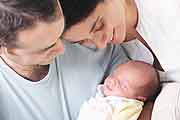
MONDAY, April 29 (HealthDay News) — With the number of home births rising, the American Academy of Pediatrics has issued a policy statement on the practice that includes a recommendation that there be a caregiver who’s present solely to take care of the newborn.
“Babies deserve the best care they can get,” said Dr. Kristi Watterberg, lead author of the statement and a professor in the division of neonatology at the University of New Mexico. “And we need to support women wherever they choose to give birth.”
There are a number of reasons women may choose to give birth at home, according to background information in the statement. They may wish for a more family-friendly setting, increased control of the birthing process, fewer medical interventions and lower costs. The rate of home births is still under 1 percent in the United States, but it is growing, according to the policy statement.
A recent report from the U.S. Centers for Disease Control and Prevention found that the number of home births jumped 20 percent between 2004 and 2008. More than 28,000 babies were born at home in 2008, which was the highest number of home births since 1990.
Home births aren’t well supported by the medical community. Various state laws and regulations can make a home birth even harder to achieve. There also may be a lack of well-trained and willing caregivers, or support in case of an emergency. Geography can also present a problem. Travel times greater than 20 minutes to medical care have been linked to an increased risk of complications, including death of the baby, according to the policy.
Some studies have suggested that home births in the United States are linked to a twofold to threefold higher risk of neonatal death. But Watterberg said a study done in British Columbia, where there’s a more integrated system that supports mothers birthing at home, found no increased risk of neonatal death. “We need better research,” said Watterberg.
However, because the rate of home births is increasing, and because the academy wants to provide a “professional, supportive interaction” with expectant mothers, Watterberg said the group developed its new policy. The AAP recommends the following factors for a mother considering a home delivery:
- Absence of preexisting medical conditions,
- Absence of significant disease during pregnancy,
- A singleton pregnancy (no twins, triplets or higher),
- Baby’s head is facing down,
- Pregnancy has lasted at least 37 weeks, but no more than 41 weeks,
- Spontaneous labor, or labor induced as an outpatient,
- A certified nurse-midwife, certified midwife or a physician practicing within an integrated and regulated health system,
- At least one appropriately trained person whose primary responsibility is the baby (this person must be qualified to resuscitate the baby if necessary),
- Ready access to consultation,
- Assurance of safe and timely transport to a nearby hospital with a preexisting arrangement for such transfers.
Watterberg said midwives often work in teams, and one can be responsible for the baby’s care after birth.
“It’s important to remember that this is an area of strong emotion. You’ll see babies in home births have terrible things happen, but you also have terrible things happen in the hospital sometimes. Women have the right to make an informed decision,” she said.
And, if a woman chooses home birth, Watterberg said it’s important for the expectant mother to meet the person who will care for her baby after birth. “Meet with that person beforehand. Talk with them about your plans, and see if they have anything to add,” she advised.
Dr. Peter Bernstein is a maternal-fetal medicine specialist and director of the perinatal safety program at Montefiore Medical Center in New York City. He said: “A woman planning a home birth has a lot of due diligence to take care of that she doesn’t have to worry about in the hospital, like making sure the correct equipment is there, that the staffing is there and qualified.
“I understand where women are coming from. A hospital birth can become very medicalized and women feel a loss of control, but I’m nervous about home births. Too many simple things can turn into disasters at home. Even in low-risk women, things can go wrong. Then you may be 20 minutes from the hospital, and it’s another 15 minutes once you get to the hospital before you can get the baby out in an emergency,” explained Bernstein, who acknowledged that he treats high-risk pregnancies, so he tends to see more complicated births.
“I’d like to see a middle ground. I’d like to see more birthing centers associated with hospitals. Bring the home birth movement to a setting that feels more like home, but is attached to the hospital,” he said.
But, he added, “In a low-risk woman, who can set it up properly, home birth shouldn’t be outlawed. A woman can have the choice to have her baby at home.”
The full policy statement is published online April 29 and will appear in the May print issue of the journal Pediatrics.
More information
Learn more about home births from the American College of Obstetricians and Gynecologists.

